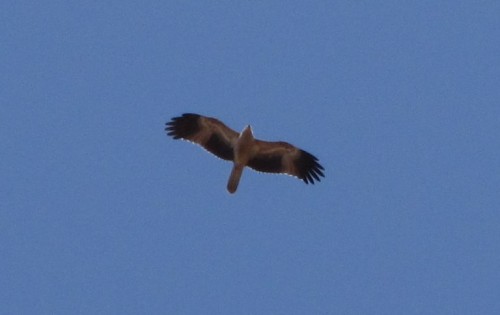Whistling Kite overhead at Pangarinda
Last week I wrote about the Tree Martins I saw and photographed at the Pangarinda Botanic Gardens near Wellington in South Australia. We were having an afternoon relaxing in the gardens to celebrate my wife’s birthday. You can read about the Tree Martins here.
While we were having a cuppa and some birthday cake with our friends I was taking note of all the birds I saw and heard. It was a lovely sunny day with a cooling breeze making the afternoon very pleasant indeed.
During the afternoon we saw and heard many birds, including plenty of New Holland Honeyeaters, both Red and Little Wattlebirds, Rainbow Bee-eaters, White-browed Babblers and even several Brown Quail. Go to the reading list at the end of this post for a link to the article about the quail.
While we were sitting at the picnic table having our afternoon cuppa a Whistling Kite soared overhead a number of times. I managed to get one reasonable photo, the one shown above. I still have yet to master the art of taking photos of birds in flight. The other shots are either too blurry, or too far away to be useful.
Whistling Kites are quite common along the Murray River in South Australia. The botanic gardens at Wellington are barely 500 metres from the river and possibly even closer to some of the reed-covered banks nearby, so I was not surprised to see one overhead. In fact, this species is common throughout most of mainland Australia where suitable habitat exists. Their preferred habitat includes open woodlands usually near water, along creeks, rivers, lakes and swamps where there are suitable nesting and roosting trees. They occasionally can be seen in Tasmania too.
Further reading:
- Tree Martins all a twitter
- Calling up a Brown Quail
- Birds and plants of the Pangarinda Arboretum (this was the early name for these gardens).
Whistling Kite at Monarto Zoo, South Australia
Yesterday I wrote about the Black Kite I saw on a visit to Monarto Zoo last year. Just before that sighting I took the above photo of a Whistling Kite. This was soaring quite a bit higher than the Black Kite, so the photo is nowhere near as good. Clicking on the photo will enlarge it slightly.
Whistling Kites are widespread throughout most of Australia. Their preferred habitats include open forest, hilly areas, timbered watercourses and around lakes, swamps, estuaries and mudflats. I have usually seen this species as a single bird, though along the nearby River Murray I have occasionally seen two or three near each other.
The name comes from the distinctive shrill whistling call. When breeding they make a large platform of sticks high in a eucalypt tree (or other convenient tree). This nest can be re-used and added to over many years until it is quite large.

